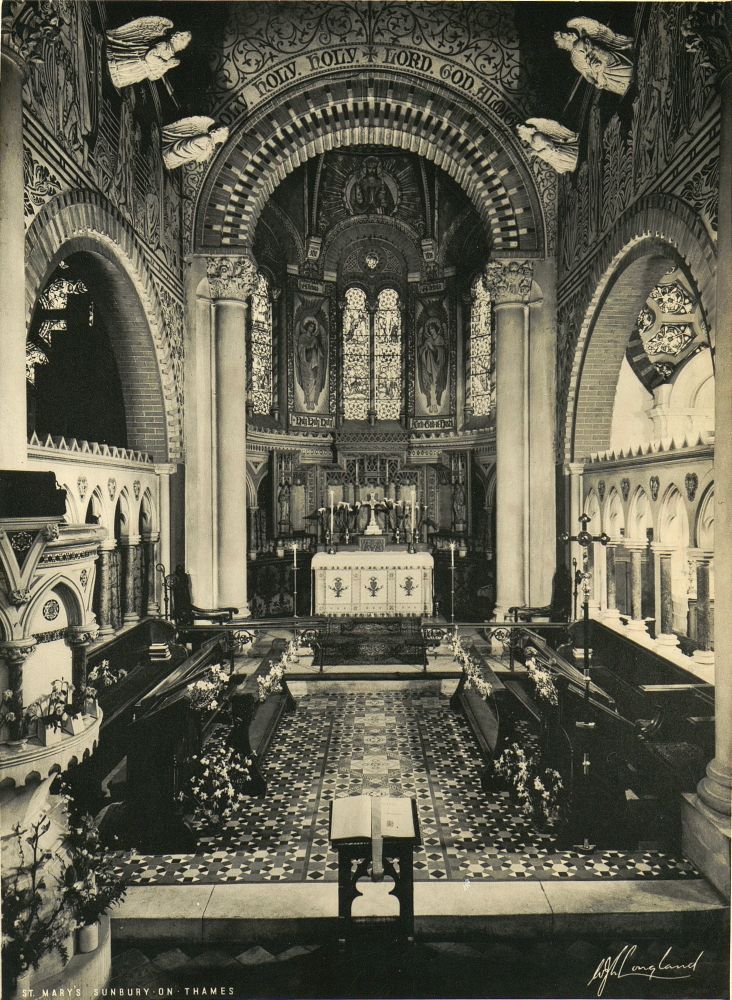The two larger photographs are by Phil Beauchamp, who also very kindly provided the two historical photographs, and much of the information. Remaining photographs by George P. Landow. [You may use the latter without prior permission for any scholarly or educational purpose as long as you (1) credit the photographer and (2) link your document to this URL in a web document or cite the Victorian Web in a print one. Click on all images to enlarge them.]

Interior of St Mary's Church, Sunbury-on-Thames, Surrey. Original architect Stephen Wright (1752), but extensively altered by Samuel Sanders Teulon in 1856, with further enrichment in the 1890s by George Heywood Sumner (1853-1940) and a local artist, George Ostreham.



Left to right: (a) The chancel viewed from the nave. (b) The chancel viewed from the gallery. (c) Teulon's arcades and Salviati mosaic work at the side of the chancel. Teulon was responsible for the general structure of the east end of the church, also for the dazzlingly polychromatic brickwork and (in the picture on the right) the brilliant mosaic inlays with which he adorned the chancel. The mosaics, of Venetian Salviati glass, certainly helped to create the effect of a "glittering Byzantine temple" to which he aspired (qtd. in A History, p. 9). Other decorations were added later. These include the paintings on the apse wall. The seraphim between the west windows, seen left and centre here, were painted on canvas by a local artist, George Ostreham, and added in 1892 "as part of a thank-offering for Queen Victoria's long and happy reign" ("Tour," p.3).


Left: Close-up of chancel roof and apse. Right: Detail of the apse. Ostreham's Christ the King is shown at the top centre of the apse wall. On either side of the chancel, in front, are other late Victorian Arts and Crafts elements, Sgraffito murals by George Heywood Sumner, also from 1892, and projecting angels added between 1892 and 1900. The apse itself is gloriously elaborate, very much of the same era as the Compton Cemetery Chapel, also in Surrey. The involvement of a local artist was typical of these kinds of collaborative works.

West end of the church, showing the iron-ornamented gallery. The attractive railings here are original. It seems more than likely that Teulon was also responsible for the cast-iron columns used in St Mary's. If so, "he was one of the first to introduce them into churches" (A History, p. 9).



Left to right: (a) The barrel roof that existed when Teulon was busy here, since replaced by a lower and much less aesthetically-pleasing flat roof. Notice the original gallery railings, that were retained, and the decorative heads of the columns. (b) St. Bartholomew and St. Philip — one of the striking stained glass windows designed by George Ostreham, and executed by Joseph Chater & Sons in 1899. Other windows have been attributed to the famous firm of Clayton & Bell. (c) A 1926 picture of the interior. This shows, amongst other previous arrangements, the choir-stalls in place before the choir was moved to the gallery, and Teulon's original Victorian tiling.
This is very much a living church, with its roots going back to a medieval parish church, and with work to renew and maintain it set to continue into the future. Naturally, the interior looks somewhat "gloomy" and "depressing" with work in progress — these were Nikolaus Pevsner's complaints, when he visited it in 1969 during a period of disuse (Pevsner et al. 470). Naturally, too, there have been both losses and gains from the changes illuminated by St Mary's lovely stained glass windows. No longer to be seen, for instance, are Teulon's west tower porch; the "buttress-like structures" that he added on either side of Wright's tower to house the stairs to the gallery; the distinctive roof that harmonised so well with his alterations; and the patterned Victorian floor tiles, now covered with plain modern flooring. The church must have been a riot of colour when these tiles were visible. On the other hand, the chancel has clearly benefited from being decluttered, and the elaborate mid- and late-Victorian work here makes a tremendous impact. More could be said about the church and its fittings, but perhaps the most important point is that no one who visited St Mary's now could possibly think it "gloomy"!
Other Views
- St Mary the Virgin, Sunbury (Exterior)
- The sgraffito Annunciation by Heywood Sumner, in St Mary's Church, Sunbury
- The sgraffito Epiphany by Heywood Sumner, in St Mary's Church
- Examples of Stained Glass Windows in St Mary's executed by Clayton & Bell
- Examples of Stained Glass Windows in St Mary's designed by the Ostrehans
Sources
Eberhard, Robert. Stained glass windows at St Mary, Sunbury, Surrey." Church Stained Glass Windows. Web. 3 0ctober 2011.
A History of the Parish & Church of St Mary's, Sunbury-on-Thames, 2009. Booklet available at the church.
Nairn, Ian, Nikolaus Pevsner and Bridget Cherry. The Buildings of England: Surrey. Harmondsworth: Penguin, 2nd ed. 1971.
"A Tour of St Mary's, Sunbury-on-Thames," Nov. 2007. Leaflet available at the church.
Last modified 25 November 2015